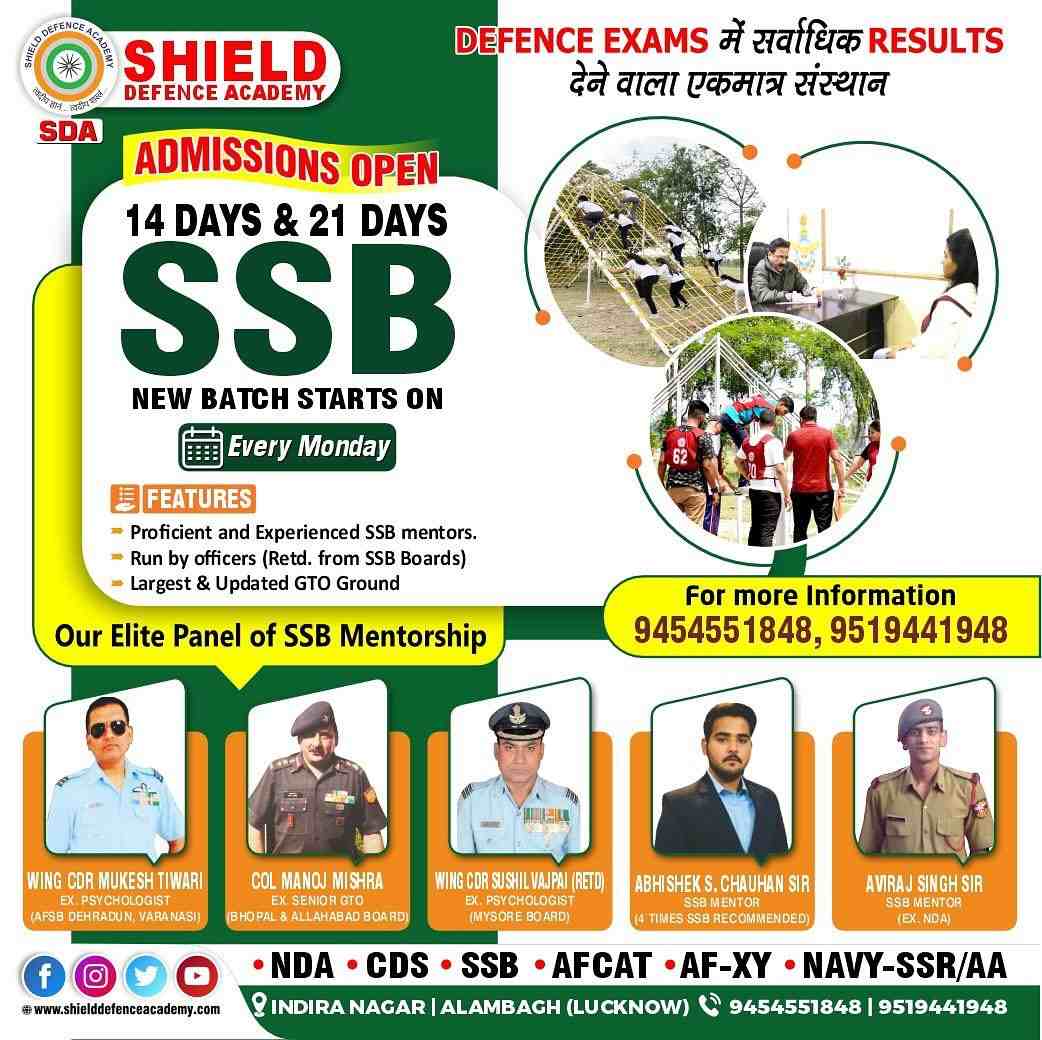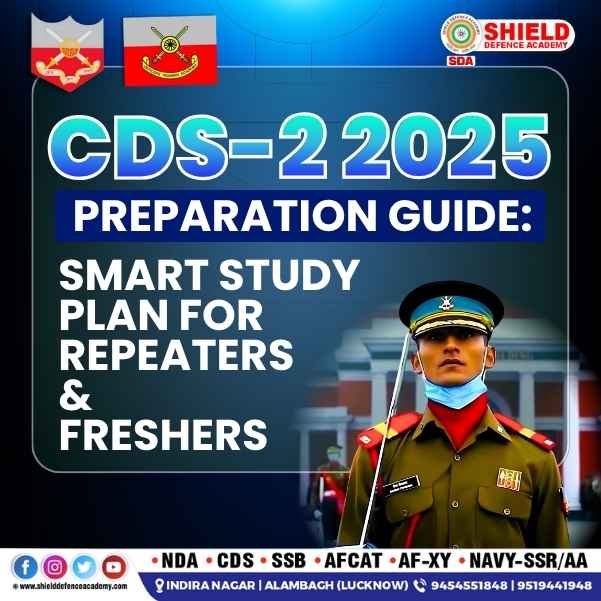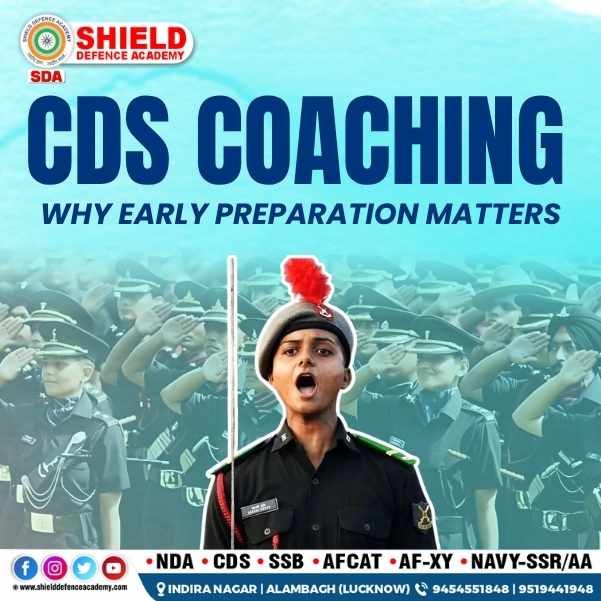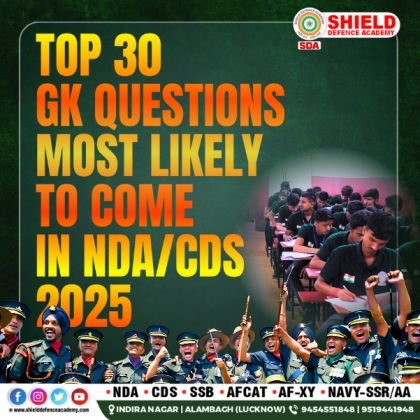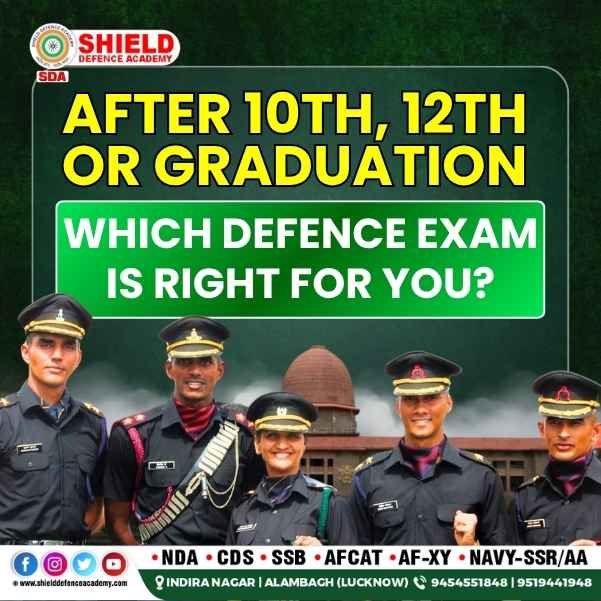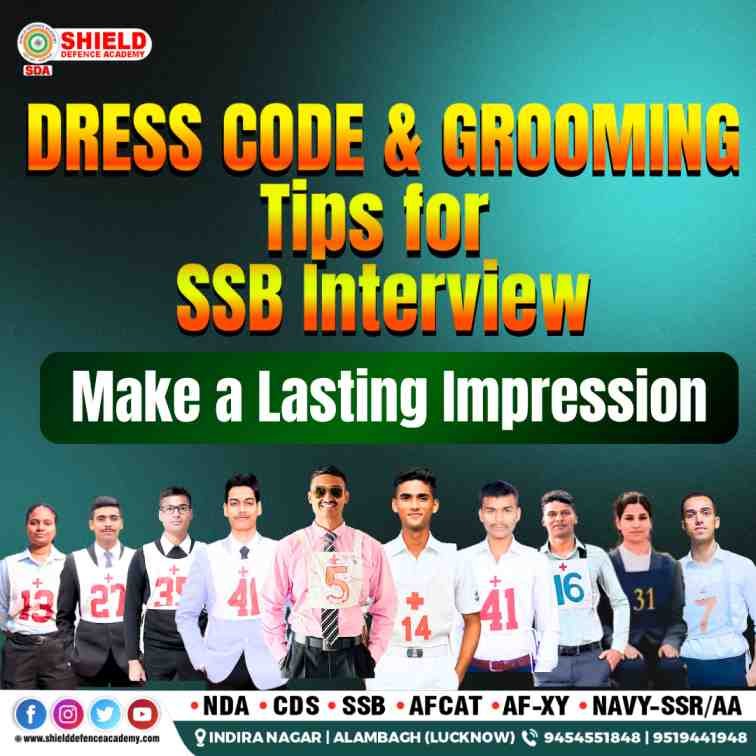Review the comprehensive SSB interview procedure and selection process and explore the day-wise breakdown and additional selection details with Shield Defence Academy. This includes a thorough breakdown of the psychological, group testing, and personal interview stages, culminating in the final conference assessment.
SSB Interview procedure at Shield Defence Academy:
The SSB interview comprises two stages: Stage-1 and Stage-2.
Stage-1 involves the (a) Officer Intelligence Rating (OIR) Test,
(b) Picture Perception and Description Test (PPDT).
Stage-2 encompasses (a) Psychological Tests,
(b) Group Testing Officer (GTO) Tasks, and
(c) Personal Interview.
The interview culminates with a Conference on the last day. These comprehensive stages assess a candidate’s psychological, physical, and leadership attributes to determine their suitability for a career in the armed forces.
In this blog, we will delve into a comprehensive explanation of the 5-day SSB interview procedure, which is vital for aspiring Army, Navy, and Air Force Officers. The SSB interview is a crucial part of the selection process, encompassing a series of tasks and tests designed to assess candidates’ potential. Understanding the nature of the SSB interview, as well as the various assessments involved, is crucial for candidates aiming to secure a career in the armed forces.
Throughout the blog, readers will gain valuable insights into the intricacies of the SSB interview, exploring its significance and the essential details that contribute to the selection of capable and dedicated individuals to serve in the military. Additionally, we will highlight the expertise and guidance offered by Shield Defence Academy, a leading institution renowned for its comprehensive facilities and mentorship tailored to support candidates preparing for the SSB interview.
The SSB interview process is a rigorous and comprehensive 5-day evaluation designed to assess candidates on parameters such as leadership, psychological aptitude, physical fitness, and social skills. This intensive examination aims to gauge the suitability of candidates for a career in the armed forces, requiring them to demonstrate their competence and potential across various domains essential for military service.
As aspiring candidates gear up for the SSB interview, it is imperative to familiarize themselves with the comprehensive 5-day assessment process, along with the nuances of psychological tests, personal interviews, and GTO tasks. Many individuals approaching this evaluation may lack prior experience, potentially leading to difficulties during the SSB interviews for this, in this blog written in the supervision of Ex Armed Force Officers for the benefit of the aspirants. So, to understanding the do’s and don’ts of the SSB interview, as well as the essential documentation required, will be informed to every aspirant in detail by Shield Defence Academy.
Eager candidates can benefit from delving into the intricacies of the SSB interview procedure and exploring various resources aimed at aiding in their preparation before embarking on their first attempt. By acquainting themselves with the detailed process and seeking guidance from credible sources, candidates can enhance their readiness and equip themselves for the challenges inherent in the SSB interview. Emphasizing preparation and familiarity with the expectations of the assessment fosters a proactive approach, thereby bolstering candidates’ confidence and prospects for success in their pursuit of a career in the armed forces.
From the very outset of the classes, Shield Defence Academy ensures that its aspirants are meticulously prepared for the SSB interview process. With a dedicated approach, the academy instills in candidates the requisite skills and knowledge essential for excelling in the rigorous evaluation. Through comprehensive guidance and strategic training by Ex Armed Force Officers from SSB Interview board, aspirants are equipped with the acumen and readiness vital for navigating the multifaceted components of the SSB interview. Shield Defence Academy’s proactive and holistic approach from day one underscores its commitment to cultivating well-prepared and capable individuals poised to thrive in the SSB interview process and embark on successful careers in the armed forces.
Understand the 5-Day SSB Interview Process with Shield Defence Academy:
Day 0: Reporting Day for SSB interview
On the reporting day at the SSB board, candidates are required to undergo document verification and complete the necessary paperwork, including the Personal Information Questionnaire (PIQ) forms. Shield Defence Academy offers practice forms for Personal Information Questionnaire (PIQ) to its students to help them prepare for the SSB interview process. Upon arrival at the designated location indicated in the call letter, typically the Movement Control Office (MCO), candidates go through this initial process alongside others who are also reporting on the same day.
The presence of fellow candidates simplifies the reporting procedure, ensuring a smooth commencement of the SSB interview journey without encountering significant difficulties. This marks the beginning of the structured assessment process, laying the foundation for the subsequent stages of the SSB evaluation.
Day 1: Screening Test for SSB interview
The screening process aims to identify potential candidates from the pool of reported individuals for a specific entry. It involves a series of activities designed to assess the candidates’ aptitude and suitability. These activities may include Officers Intelligence Tests (OIR), Picture Perception and Discussion Test (PPDT), to evaluate various aspects of the candidates’ potential. The screening process serves as the initial stage to identify individuals with the capabilities and attributes essential for successful progression in the SSB interview evaluation.
(i) Officer Intelligence Rating (OIR):
The OIR Test, or officers’ intelligence rating test, encompasses Verbal and Non-verbal assessments. While the OIR Test is a fundamental aptitude evaluation, thorough preparation is essential. Following the test, there is a brief break before transitioning to the PPDT.
(ii) Picture Perception and Discussion test (PPDT):
The Picture Perception and Discussion Test (PPDT) involves story writing and group discussion. After viewing a picture for 30 seconds, candidates have 3 minutes to craft a story inspired by the image. Subsequently, in groups of 14-15, each candidate narrates their story within 1 minute, followed by a collaborative discussion on the picture. This crucial assessment is pivotal for clearing the screening process and advancing to stage-2 testing.
If you are preparing for the OIR Test and PPDT, you can access the best OIR Classes at Shield Defence Academy. The academy offers regular classes by expert guidance of Ex Armed Force Officers from SSB Interview Board focusing on the OIR and PP&DT, also known as the Officers’ Intelligence Rating and Picture Perception and Discussion Test, which encompasses both Verbal and Non-verbal Test components. While the OIR Test is a fundamental aptitude assessment, thorough preparation is advantageous. At Shield Defence Academy, aspirants receive comprehensive training to excel in these areas, ensuring they are well-prepared for both the tests.
Day 2: Psychological Testing for SSB Interview
The psychological test is a critical component of the officer selection process, assessing candidates’ suitability for the role through projective tests. These tests probe into the candidate’s psyche, evaluating their emotional intelligence, problem-solving skills, and decision-making abilities. With time being of the essence, candidates must provide prompt, authentic responses that reveal their true psychological makeup. This evaluation encompasses various aspects of the candidate’s personality and cognitive processes, ensuring that only those who meet the psychological criteria are selected for the officer position. Time management and cognitive agility are essential for success in this test. The tests are as follows:
a) Thematic Apperception Test [TAT]
b) Word Association Test [WAT]
c) Situation Reaction Test [SRT]
d) Self-Description Test [SDT]
a) Thematic Apperception Test [TAT]:
You will view 11 pictures, each for 30 seconds, with 4 minutes to write a story based on each. After 4 minutes, a new picture will appear for 30 seconds, repeating until the last blank slide. Your task is to craft a story for each image within the given time frame, stimulating your story perceiving abilities.
b) Word Association Test [WAT]:
As each word flashes, you need to quickly respond with the first sentence that comes to mind. The challenge is to seamlessly link each sentence to form a continuous, flowing paragraph depicting a stream of consciousness. With only 15 seconds per word, the exercise demands rapid, unbroken thought process, sparking a spontaneous and unrestrained outpouring of connected sentences and ideas.
c) Situation Reaction Test [SRT]:
You’ll receive a booklet with 60 situations to respond to within 30 minutes. Your answers should be based on these situations.
d) Self-Description Test [SD]:
Write opinions about yourself from your parents, friends, teachers, and yourself, and mention what you would like to develop in the future. You have 15 minutes to complete this task.
Join Shield Defence Academy’s interactive classes for the test preparation program. Sharpen your skills and prepare for the unexpected with our engaging exercises. Get ready to unleash your imagination and ace the above mentioned tests with Shield Defence Academy’s unique approach to preparation. Are you ready to embark on this thinking and writing adventure as it’s all about your thinking and writing speed?
Day 3 and 4: Group Testing
The third and fourth days involve a series of group testing activities designed to evaluate the candidate’s group dynamics, leadership qualities, and teamwork skills. These activities include group discussions, group planning exercises, outdoor group tasks, and an individual obstacle course. The candidates’ performance in these activities is closely observed and assessed by the SSB board.
The series of tasks comprises various activities designed to assess participants in different ways.
The tasks include back-to-back Group Discussions (GD) on current affairs, a Group Planning Exercise (GPE) where each candidate must outline their plan for a given problem and map, followed by a group discussion to reach a consensus plan. In the Progressive Group Task (PGT), participants work together to navigate obstacles using supporting materials like ropes and planks it is called Group Obstacles Race (GOR). The Half Group Task (HGT) is similar to PGT but with half the number of group members, offering more opportunities to display individual potential. The Individual Obstacles Task (IOT) requires individuals to attempt ten obstacles independently, each with varying point values.
Additionally, there is the Command Task where a participant assumes the role of a commander and must navigate obstacles with the help of 2-3 chosen subordinates. The Snake Race involves competing with other groups while holding a snake-like rope and navigating various obstacles. The Individual Lecturette requires each candidate to deliver a 3-minute lecture on a self-selected topic from a set of four. Finally, the Final Group Task (FGT) provides another opportunity for participants to showcase their potential in a task similar to PGT.
The Shield Defence Academy prepares its candidates from the very beginning for these tests. Throughout these tasks, the focus is on assessing the participants’ ability to work collaboratively in a group, exhibit leadership, problem-solving skills, and individual potential and Academy’s Ex Armed Forces Officers from SSB Interview Board. The tasks are designed, by Officers is based on SSB pattern, to challenge participants in different ways, from group dynamics and decision-making to individual performance under pressure. These activities provide a comprehensive view of the participants’ abilities and are instrumental in evaluating their overall potential for the given role or purpose.
Day 5: Conference and Interview
The final day of the SSB interview includes a conference where the SSB board members review and discuss each candidate’s performance over the past four days. This is followed by the individual candidate’s interview with the President of the Board. The interview focuses on the candidate’s overall performance, personal goals, and aspirations. The candidate may also be asked to provide insights into current affairs and general knowledge.
In conclusion, the SSB interview process is a pivotal step for aspiring Army, Navy, and Air Force Officers, and a clear understanding of its structure and assessments is essential for success. Shield Defence Academy’s commitment to providing facilities and guidance, along with the expertise of Retired Armed Forces Officers from The SSB Interview Board, positions aspiring candidates for success in their pursuit of a career in the armed forces.
